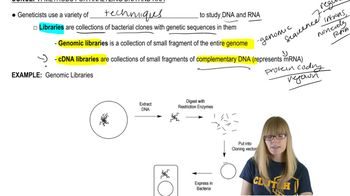Table of contents
- 1. Introduction to Genetics51m
- 2. Mendel's Laws of Inheritance3h 37m
- 3. Extensions to Mendelian Inheritance2h 41m
- 4. Genetic Mapping and Linkage2h 28m
- 5. Genetics of Bacteria and Viruses1h 21m
- 6. Chromosomal Variation1h 48m
- 7. DNA and Chromosome Structure56m
- 8. DNA Replication1h 10m
- 9. Mitosis and Meiosis1h 34m
- 10. Transcription1h 0m
- 11. Translation58m
- 12. Gene Regulation in Prokaryotes1h 19m
- 13. Gene Regulation in Eukaryotes44m
- 14. Genetic Control of Development44m
- 15. Genomes and Genomics1h 50m
- 16. Transposable Elements47m
- 17. Mutation, Repair, and Recombination1h 6m
- 18. Molecular Genetic Tools19m
- 19. Cancer Genetics29m
- 20. Quantitative Genetics1h 26m
- 21. Population Genetics50m
- 22. Evolutionary Genetics29m
18. Molecular Genetic Tools
Methods for Analyzing DNA
Problem 6a
Textbook Question
A victim of murder is found to have scrapings containing skin cells under several of her fingernails. Genetic analysis confirms that the DNA isolated from these cells came from the same individual and does not match the DNA of the victim. The results shown below are for six CODIS STR markers from the crime scene DNA (from under the victim's fingernails and presumed to be the murderer's), and from three suspects (A, B, and C) who have been detained for questioning about the murder. Is there a failure to exclude any of the suspects? Explain.
 Verified step by step guidance
Verified step by step guidance1
Identify the CODIS STR markers used in the analysis. These are specific regions of DNA that are highly variable among individuals and are used for forensic identification.
Compare the alleles (specific versions of a gene) at each STR marker from the crime scene DNA with those from each suspect. Each individual has two alleles per marker, one inherited from each parent.
For each STR marker, check if the alleles from the crime scene DNA match any of the alleles from the suspects. A match means that the suspect cannot be excluded as a potential source of the DNA.
Determine if there is a complete match across all STR markers between the crime scene DNA and any of the suspects. A complete match would indicate a failure to exclude that suspect.
If any suspect has alleles that do not match the crime scene DNA at any STR marker, that suspect can be excluded. If a suspect matches at all markers, they cannot be excluded.
Recommended similar problem, with video answer:
 Verified Solution
Verified SolutionThis video solution was recommended by our tutors as helpful for the problem above
Video duration:
2mPlay a video:
Was this helpful?
Key Concepts
Here are the essential concepts you must grasp in order to answer the question correctly.
DNA Profiling
DNA profiling is a forensic technique used to identify individuals based on their unique DNA characteristics. It often involves analyzing short tandem repeats (STRs), which are specific sequences of DNA that vary among individuals. By comparing the STR markers from a crime scene sample to those of potential suspects, investigators can determine if there is a match, which is crucial in criminal investigations.
Recommended video:
Guided course

DNA Proofreading
CODIS STR Markers
The Combined DNA Index System (CODIS) utilizes specific STR markers to create DNA profiles for individuals. These markers are selected for their variability among the population, making them effective for distinguishing between different individuals. In forensic analysis, comparing the STR profiles from a crime scene to those of suspects helps to identify or exclude potential perpetrators based on genetic evidence.
Recommended video:
Guided course

Mapping with Markers
Exclusion and Inclusion in Forensic Genetics
In forensic genetics, exclusion occurs when a suspect's DNA profile does not match the DNA found at a crime scene, indicating they are not the source of the evidence. Conversely, inclusion happens when a suspect's profile matches the evidence, suggesting they could be the source. Understanding these concepts is essential for interpreting DNA analysis results and determining whether any suspects can be excluded from consideration in a criminal case.
Recommended video:
Guided course

Descriptive Genetics

 7:40m
7:40mWatch next
Master Methods for Analyzing DNA and RNA with a bite sized video explanation from Kylia Goodner
Start learningRelated Videos
Related Practice


